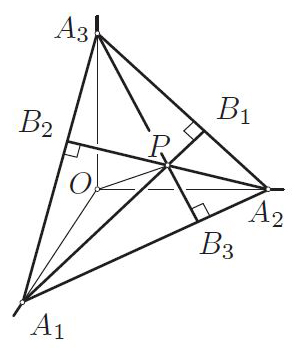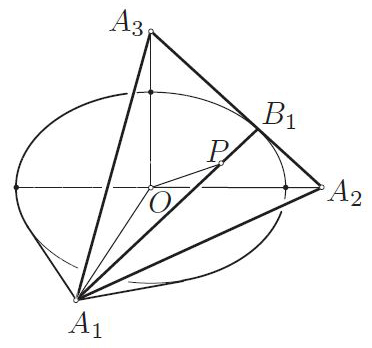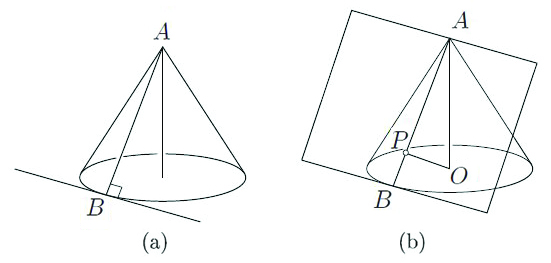A Perspective on Altitudes

In my “geometry for teachers” class a few years ago, I was trying to explain why the altitudes in a triangle are concurrent. The (perhaps) most common proof, which identifies the concurrency point as the orthocenter of another larger triangle, still felt insufficiently direct to me. I also wondered whether a more direct geometrical characterization of the concurrency point exists.
As it turns out, embedding the problem in three dimensions yields an additional insight. To begin, we shove an arbitrary acute1 triangle \(A_1A_2A_3\) into the corner of a rectangular quadrant, as shown in Figure 1; each vertex now lies on a coordinate axis.
I claim that the concurrency point of the altitudes is precisely the foot \(P\) of the perpendicular from the origin onto the plane of the triangle.

Proof
With \(P\) defined as in the previous sentence, let \(B_1\) be the point at which the line \(A_1P\) intersects with side \(A_2A_3\).
I claim that \(A_1B_1\) is an altitude of the triangle. Indeed, \(A_2A_3 \perp OP\) (since \(A_2A_3\in {\rm plane}(A_1A_2A_3) \perp OP\)) and \(A_2A_3\perp \ OA_1\) (since \(A_2A_3\in{\rm plane}(O A_2A_3)\perp OA_1\)). In summary, because \(A_2A_3\) is normal to two lines (\(OP\) and \(OA_1\)) in the plane \(POA_1\), it is normal to every line in that plane and thus to \(A_1B_1\). So \(A_1B_1\) is indeed an altitude. The same argument applies to \(A_i B_i\) for \(i=2, 3\), meaning that all altitudes pass through \(P\). Q.E.D.
Proof 2
Here is a slightly different way to express essentially the same idea. Referring to Figure 2, construct the circular cone tangent to the plane of the triangle, with vertex \(A_1\) and axis \(A_1O\). Define \(B_1\) as the point at which the line of tangency intersects with side \(A_2A_3\). Now \(A_1B_1 \perp A_2A_3\), according to Figure 3a, and \(A_1B_1\) passes through \(P\), according to Figure 3b (with \(P\) defined as above). This shows that the altitude from an arbitrarily chosen vertex passes through \(P\). Q.E.D.

The figures in this article were provided by the author.
1 Unfortunately, this approach does not seem to extend to obtuse triangles; or perhaps I am not acute enough to find an extension.
About the Author
Mark Levi
Professor, Pennsylvania State University
Mark Levi (levi@math.psu.edu) is a professor of mathematics at the Pennsylvania State University.
Stay Up-to-Date with Email Alerts
Sign up for our monthly newsletter and emails about other topics of your choosing.



